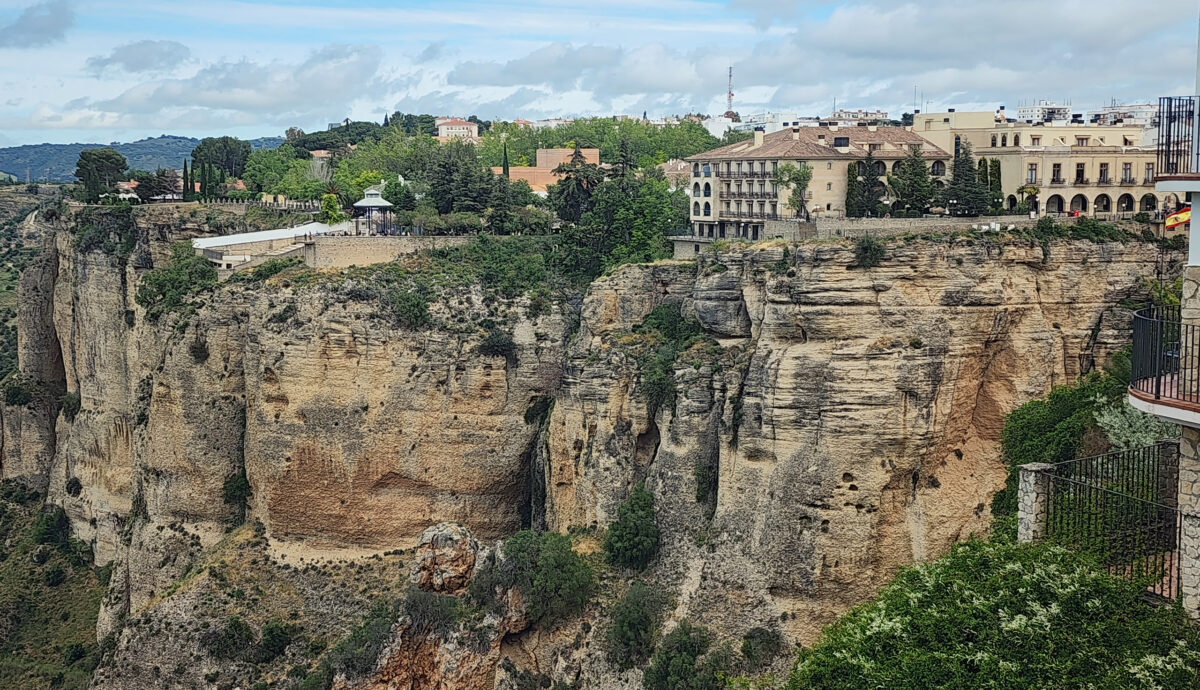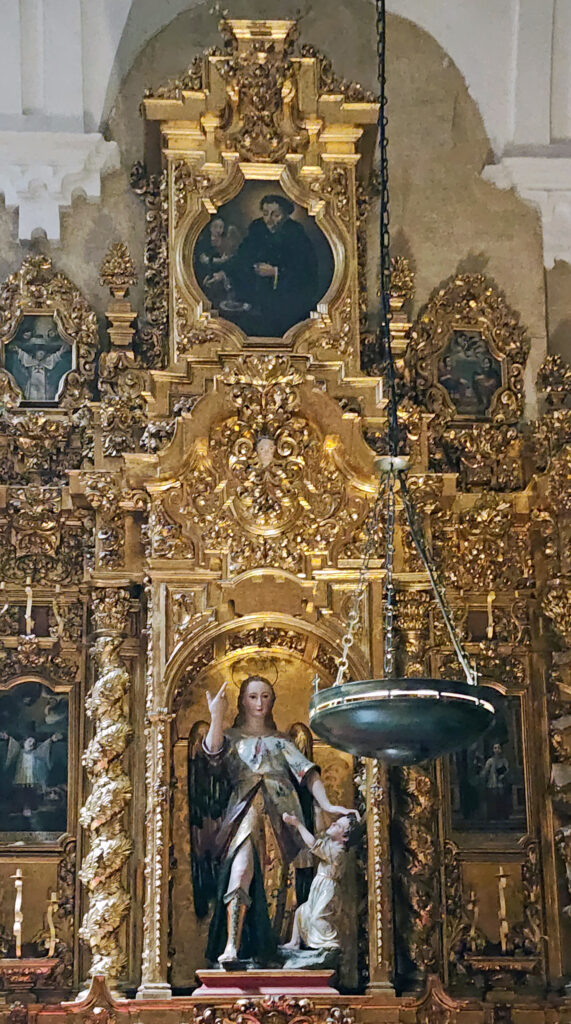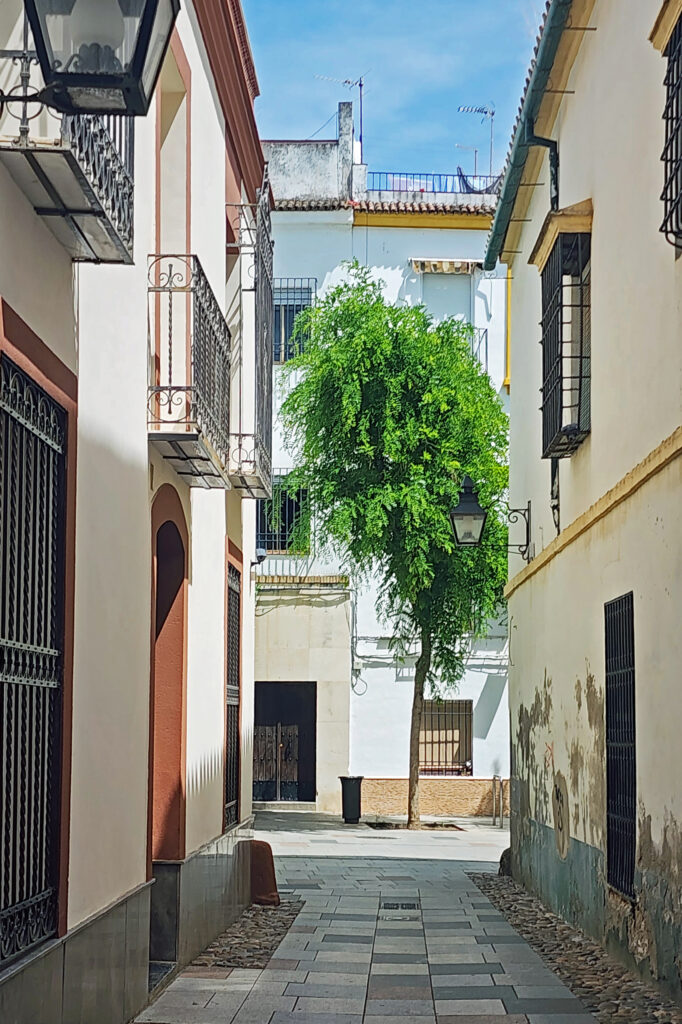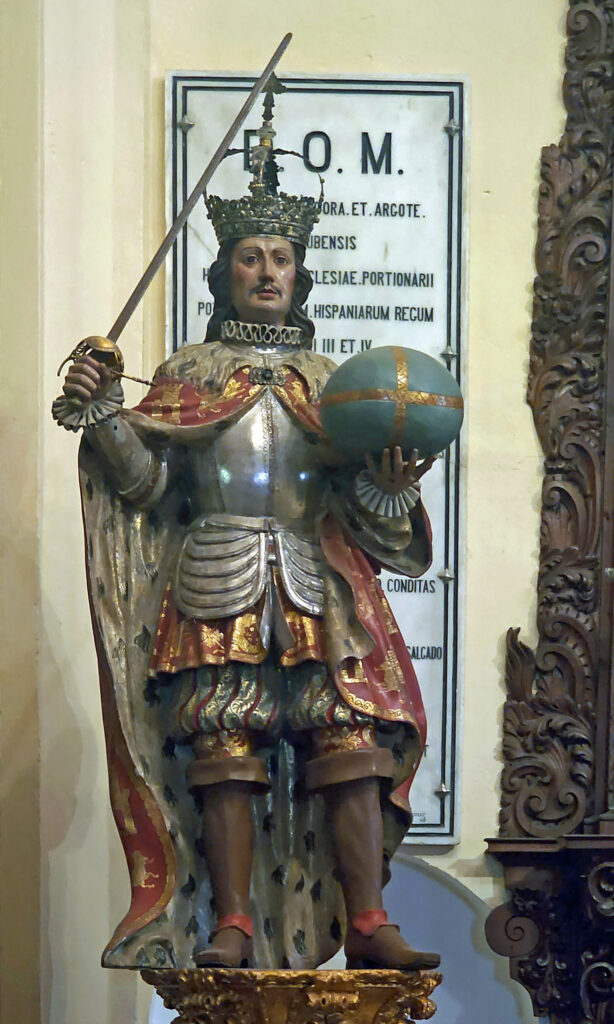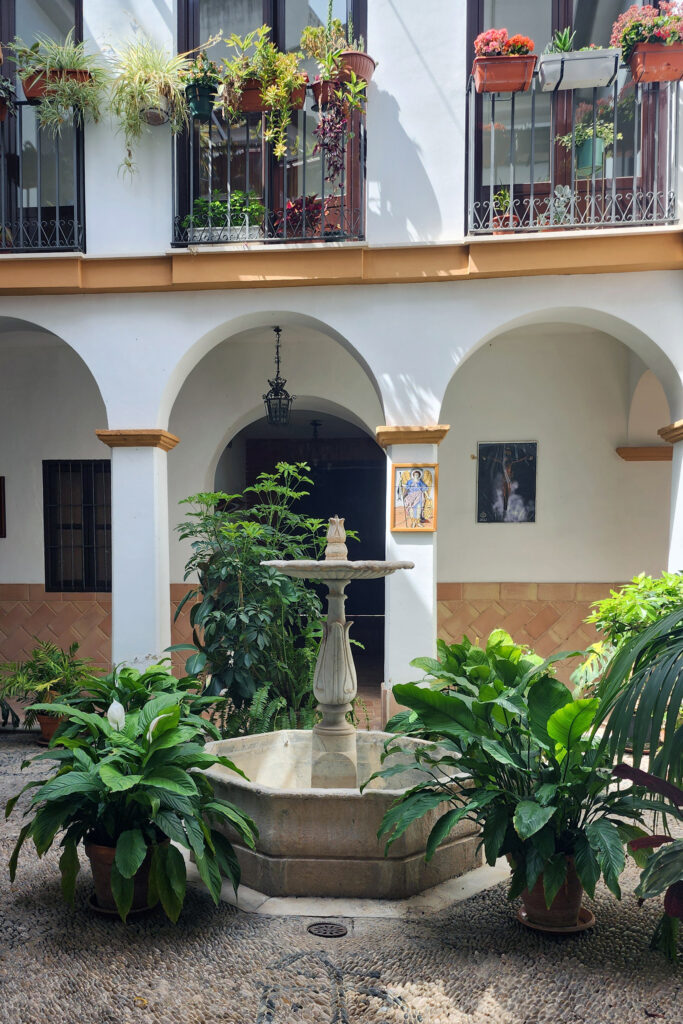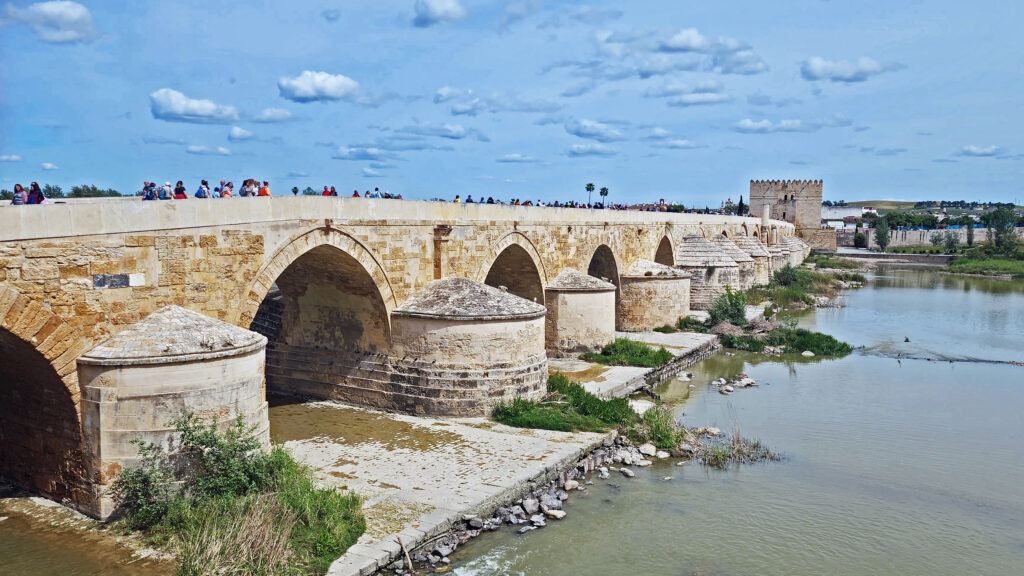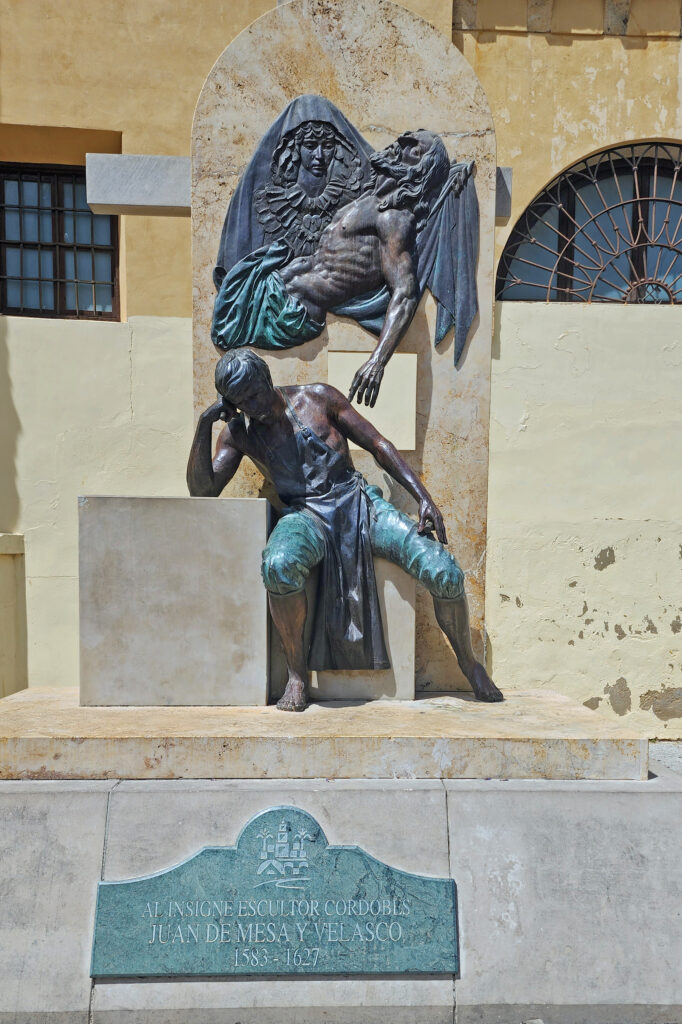by Alan K. Lee

Introduction
A TV travel show about ten or twelve years ago was my first introduced to Ronda, Spain. The spectacular canyon that splits the town made a memorable and lasting impression, and I was happy that my wife and I were able to fit a day trip to Ronda into our itinerary when we visited the Andalusia region of Spain last spring. Ronda is only about 40 miles (as the crow flies) west of Malaga, and since we were flying back from Malaga at the end of our trip, it only made sense to include a side trip to Ronda. Our day trip to Ronda also included a bonus stop in Setinel de las Bodegas.

Ronda
Ronda is divided into two sections by the 400 foot deep El Tajo Canyon of the Guadalevin River. This deep, narrow, gorge is spectacular. There’s more to the city than that, of course, but El Tajo is the main tourist draw in Ronda.
If you arrive in Ronda by car, most on-street parking is free (per Rick Steves) but empty spaces may be hard to find near the New Bridge area. There is a parking garage just north of the Alameda de Tajo and an underground parking garage at the Plaza Socorro, a block east of the bullfighting ring.


Most travelers arrive in Ronda by train or bus. From the train station it is a 15 minute walk to the New Bridge. After exiting the station, turn right onto the Avenida de Andalusia. In about a quarter of a mile, you’ll see the bus station on the right. Continue straight (the street becomes the Calle San Jose at that point), then turn left on Calle Jerez. You’ll pass the Church of Our Lady of Mercy on your right in the first block. Just beyond that, look for the Alameda del Tajo on your right. You’ll want to walk through the park to the edge of the Tagus Escarpment, a 400-foot high, nearly vertical cliff, where you’ll find your first of many viewpoints.

Follow the walkway along the edge of the cliff to the Bullring of the Royal Cavalry of Ronda (officially the Plaza de Toros de la Real Maestranza de Caballeria de Ronda), the oldest bullring in Spain (constructed in 1793). Adult admission to the bullring and the small museum there is 9€.

Past the bullring, take a right to the Mirador de Ronda, the second viewpoint you’ll encounter, and then make your way to the New Bridge. Approaching the New Bridge on the Calle Arminand, you’ll pass the Parador de Ronda, the old town hall, now a hotel, on your right. Just beyond the Parador, there is a walkway to the Paseo de Kazunori Yamauchi where you can see the west end of the El Tajo Canyon and the New Bridge. For a small fee, you can also descend a stairway into the structure of the bridge itself.


Cross the street and walk across the bridge, then take a left to another spectacular viewpoint, this one looking upstream and down into the canyon. If you want to descend into the canyon, which my wife and I did and which I recommend, provided you are in good enough condition to climb the 400 feet back up to the top, take the first left on the south side of the bridge and follow Calle Cuesta de Santa Domingo steeply downhill.

In about 300 feet you’ll come to the misnamed Casa del Rey Moro (House of the Moorish King). The house was built long after the Moors were driven out of Spain. Here you can pay a 10€ entrance fee to get to a set of 260 steps leading down to what is called the “water mine” at river level. (The house itself is closed to the public). Or do as we did, continue on the street down to the Old Bridge.


There are three bridges crossing the Guadalevin River. The lowest of the three, the Roman Bridge (Puente Romano) is almost at river level and is also the oldest. It is also called the Arab Bridge (Puente Arabe) and Puente San Miguel. The foundation of the bridge is Roman and the rebuilt structure of the current bridge dates to the Islamic era. The middle, or Old Bridge (Puente Viejo), spans the canyon about 100 feet above the river and provides good views into the canyon. Despite being called the Old Bridge, it was built in 1616, making it much newer than the Roman Bridge.

The most spectacular of the three, the New Bridge (Puente Nuevo) spans the top of the canyon, 390 feet (120 meters) above the river. The canyon here is twice as deep as it is wide. The bridge was completed in 1793, so “New Bridge” is also a bit of a misnomer.


From the Old Bridge, you can return to the New Bridge on a stairway and walkway on the opposite side of the canyon. We continued down to the Roman Bridge, though. At the bottom, you’ll find the Arab Baths to your right. Adult admission to this well-preserved archeological site is 4.50€, with discounts for students and seniors, and no charge for children under 14. We did not go in (we had four hours on our own in Ronda, but there’s a lot to see), but if you have an interest in history or architecture, it’s a cheap ticket. From the Roman Bridge, we retraced our steps, crossed the Old Bridge, and climbed back up to the top.

After having lunch at one of the many cafes in Ronda, we crossed back over the New Bridge and made our way to the Plaza de Maria Auxiliadora, where there are stairs and a paved path leading down the face of the escarpment to the New Bridge Viewpoint (Mirador de Puente Nuevo). There is a small charge to get out to the viewpoint, but you can also keep going down a steep trail to the free Giraffe Rock Viewpoint and Arab Arch. The views are well worth the effort required to climb back up.

That was all we had time for, so it was back to the bus station from there. All told, our half-day in Ronda was one of the highlights of our trip, but we could easily have spent a whole day, or maybe two, there and not run out of things to see and do. If you’re thinking of visiting Ronda, I’d suggest staying at least one night in the city. If nothing else, you’d have an evening and a morning without the crowds of day-trippers (like us).


Setinel de las Bodegas
Our tour included a stop at Setinel de las Bodegas on our way back to Malaga. Part of the town is built into the side of cliffs that line the Rio Trejo running through town. The cliff face overhangs the shops and parts of the street along the creek.

The ceilings and back walls of the shops are solid rock, and the overhang is wide enough that the fronts of the shops on the river side of the street extend up to the overhang in one section, making the street appear to be a tunnel through the cliff face. Quite a unique and interesting place.

Malaga
We included Malaga on our itinerary only because it has an international airport with easy connections to the US west coast through London. The chief attraction of Malaga is probably its many sun-drenched Mediterranean beaches, but we didn’t make it to any of them. We found the city had enough other attractions, though, to merit spending a couple of nights there even without dipping our toes in the Mediterranean.

The harbor front is very touristy, but there is a nice city park across the street and the ruins of a hilltop castle overlooking the harbor. We didn’t get up to the castle, but we did find a beautiful old church that we were able to explore and photograph, and the city has some interesting architecture. We found a nice cafe to get a bite to eat and a beer to quench our thirst (even in early May it was quite warm there), and a gelato shop in the downtown area.
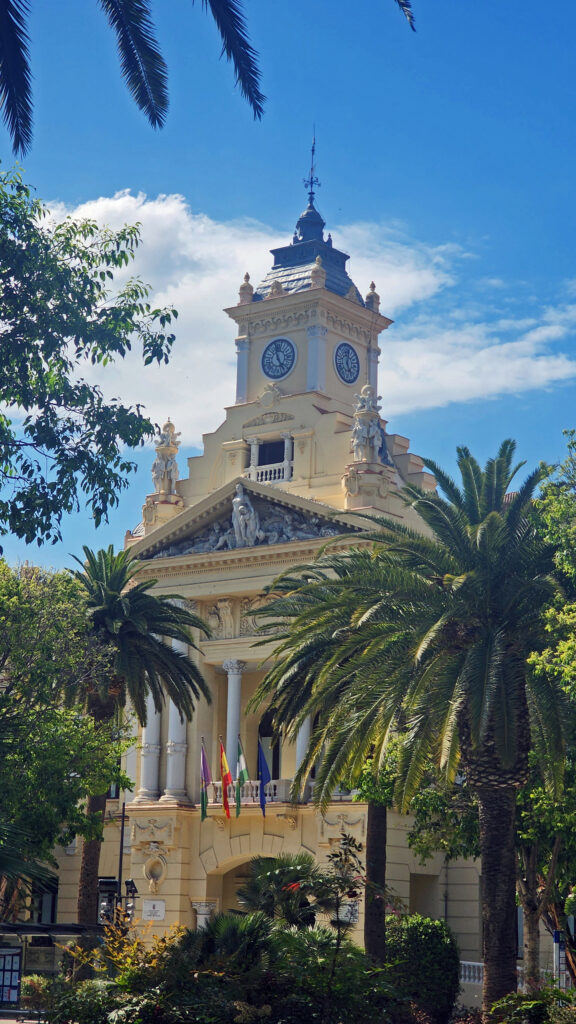

The Parque de Malaga runs for about half a mile along the Paseo de las Curas, the main street along the harbor front. We spent an hour or so wandering the park’s paths and enjoying the flora and the many fountains and sculptures.

Conclusion
Ronda is an easy side trip from Malaga, Seville, or Cordoba, Setinel de las Bodegas is a nice addition, and Malaga has some attractions of its own beyond the Mediterranean seashore. It was a nice way to end our trip.

For more on our trip to Portugal and Spain, check out my other posts:
Granada and the Magnificent Alhambra

Posted December 14, 2024
All photos © Alan K. Lee

